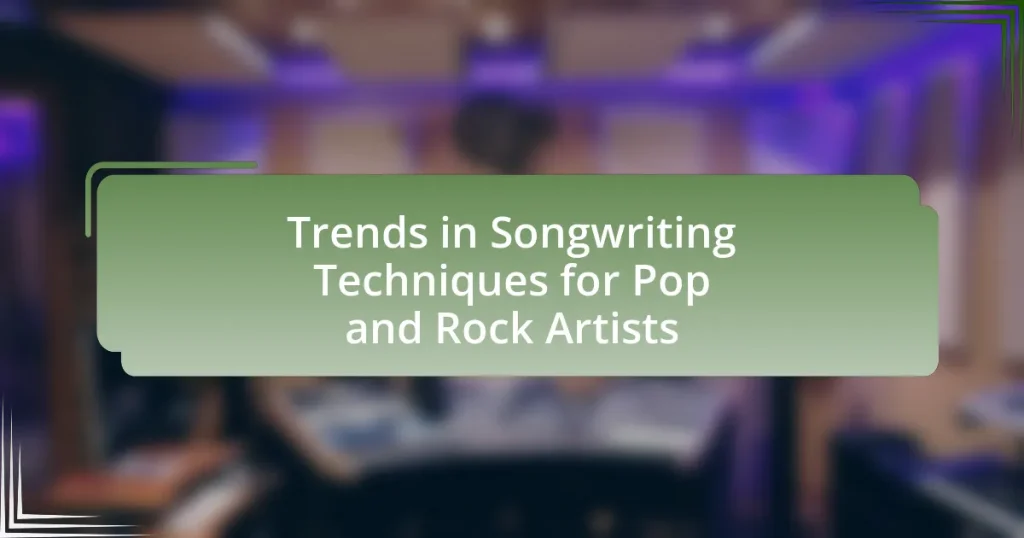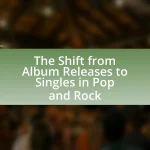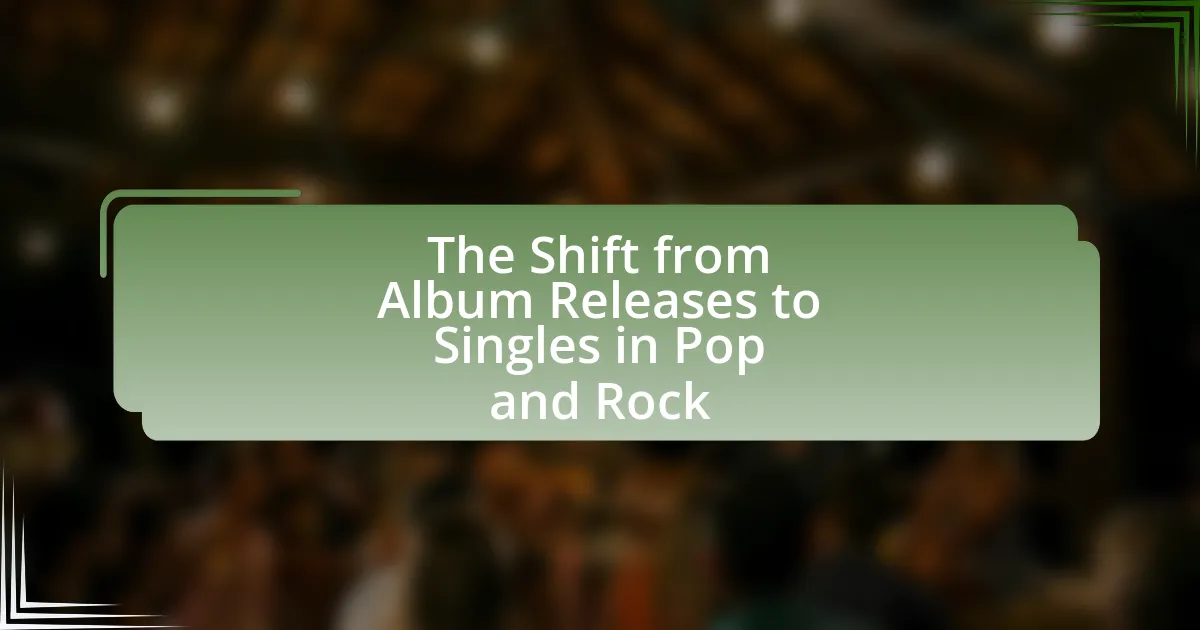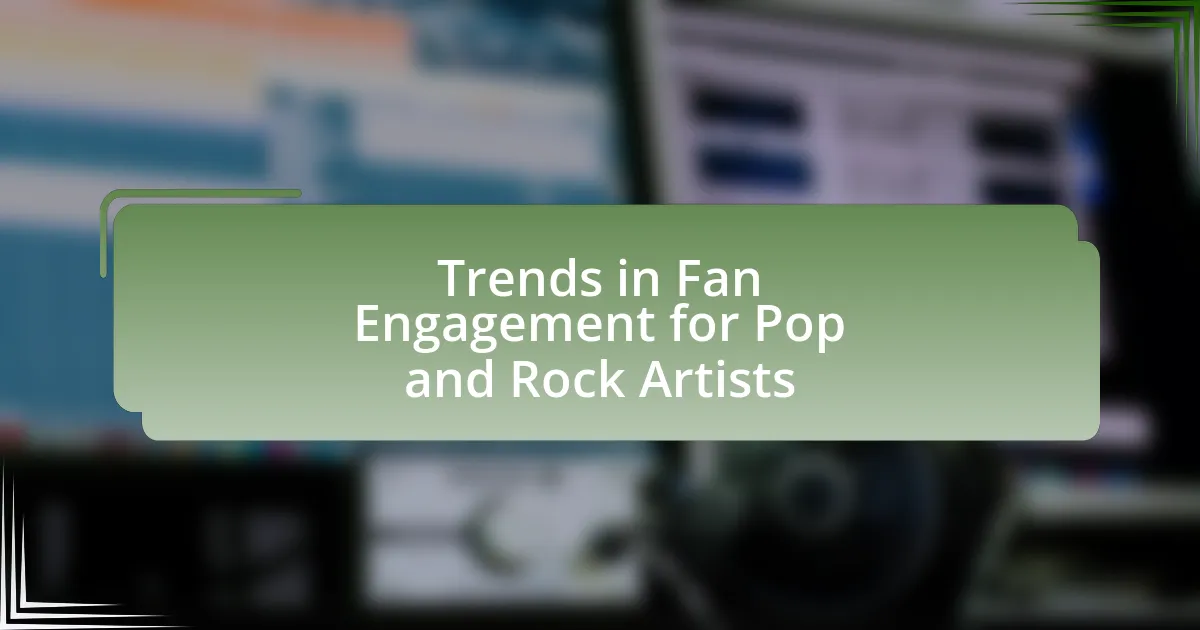The article focuses on current trends in songwriting techniques for pop and rock artists, highlighting the rise of collaborative songwriting, genre blending, and an emphasis on storytelling. It discusses how technological advancements, such as digital audio workstations and AI tools, are shaping the creative process, while cultural shifts influence lyrical themes. The piece also examines the impact of audience engagement on songwriting, the evolution of song structures, and the challenges songwriters face in adapting to industry demands. Key practices for emerging songwriters to succeed in this dynamic landscape are also outlined, emphasizing the importance of collaboration and leveraging technology.
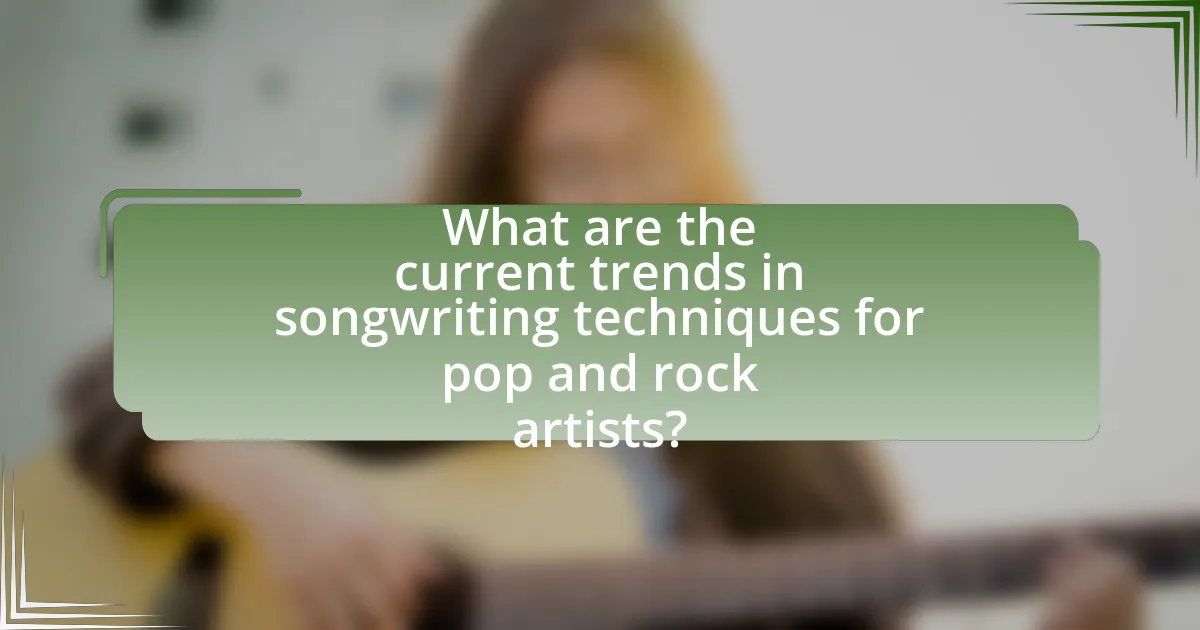
What are the current trends in songwriting techniques for pop and rock artists?
Current trends in songwriting techniques for pop and rock artists include the use of collaborative songwriting, incorporation of diverse genres, and a focus on storytelling. Collaborative songwriting has become prevalent, with artists often working together in writing camps or through online platforms, leading to a fusion of ideas and styles. Additionally, many pop and rock artists are blending elements from genres such as hip-hop, electronic, and indie, creating innovative sounds that appeal to a broader audience. The emphasis on storytelling has also intensified, with artists crafting lyrics that resonate emotionally and reflect personal experiences, which has been shown to enhance listener engagement and connection. These trends are supported by data indicating that songs with relatable narratives tend to perform better on streaming platforms, highlighting the effectiveness of these techniques in contemporary music.
How have songwriting techniques evolved in recent years?
Songwriting techniques have evolved significantly in recent years, primarily due to advancements in technology and changes in listener preferences. The rise of digital audio workstations (DAWs) has enabled songwriters to experiment with sounds and structures more easily, leading to innovative compositions that blend genres. Additionally, the use of data analytics has influenced songwriting by allowing artists to tailor their music to audience preferences, as seen in the trend of incorporating catchy hooks and relatable lyrics that resonate with listeners. This evolution is supported by the increasing popularity of platforms like TikTok, where short, engaging snippets of songs can go viral, prompting songwriters to focus on creating memorable choruses and hooks that capture attention quickly.
What technological advancements are influencing songwriting?
Technological advancements such as digital audio workstations (DAWs), artificial intelligence (AI), and online collaboration tools are significantly influencing songwriting. DAWs like Ableton Live and Logic Pro enable artists to compose, edit, and produce music more efficiently, allowing for greater experimentation with sound. AI tools, such as OpenAI’s MuseNet and Amper Music, assist songwriters by generating melodies and harmonies, thus expanding creative possibilities. Additionally, online collaboration platforms like Splice and Soundtrap facilitate real-time collaboration among songwriters and producers across the globe, enhancing the creative process and enabling diverse influences to merge in songwriting. These advancements collectively streamline the songwriting process and foster innovation in music creation.
How are cultural shifts impacting lyrical themes?
Cultural shifts are significantly impacting lyrical themes by influencing the subjects and narratives that artists choose to explore in their music. For instance, the rise of social movements such as Black Lives Matter and Me Too has led to an increase in songs addressing issues of racial injustice and gender equality, reflecting the collective consciousness and societal demands for change. This shift is evident in the works of artists like H.E.R. and Billie Eilish, who incorporate themes of empowerment and activism into their lyrics, resonating with contemporary audiences. Furthermore, the growing acceptance of diverse identities and experiences has prompted songwriters to explore topics related to mental health, sexuality, and personal struggles, as seen in the lyrics of artists like Lil Nas X and Lizzo. These changes in lyrical themes illustrate how cultural dynamics shape the storytelling and emotional resonance in pop and rock music, making it more relevant to listeners’ lives.
What role do collaboration and co-writing play in modern songwriting?
Collaboration and co-writing are essential in modern songwriting, significantly enhancing creativity and broadening artistic perspectives. Many successful pop and rock artists, such as Taylor Swift and Ed Sheeran, frequently engage in co-writing sessions, which allow them to blend diverse ideas and styles, resulting in more innovative and relatable music. Research indicates that songs created through collaboration often achieve higher commercial success; for instance, a study by the University of Southern California found that co-written songs tend to perform better on charts compared to solo-written tracks. This trend reflects the industry’s shift towards teamwork, where pooling talents leads to richer lyrical content and more dynamic melodies.
How do collaborations enhance creativity in songwriting?
Collaborations enhance creativity in songwriting by combining diverse perspectives and skills from multiple artists. This exchange of ideas fosters innovation, as different backgrounds and experiences contribute to unique lyrical themes and melodies. For instance, a study by the University of Southern California found that collaborative songwriting often leads to more varied and complex compositions compared to solo efforts, as artists challenge each other’s creative boundaries. Additionally, collaborations can introduce new techniques and genres, further enriching the songwriting process and resulting in fresh, engaging music that resonates with a wider audience.
What are the benefits of co-writing for pop and rock artists?
Co-writing offers significant benefits for pop and rock artists, including enhanced creativity, diverse perspectives, and increased marketability. Collaborating with other songwriters allows artists to blend different styles and ideas, resulting in more innovative and appealing music. For instance, a study by the University of Southern California found that songs written by multiple authors tend to perform better commercially, as they often incorporate a wider range of influences and appeal to broader audiences. Additionally, co-writing can lead to networking opportunities, expanding an artist’s reach within the industry.
How do artists incorporate audience feedback into their songwriting process?
Artists incorporate audience feedback into their songwriting process by actively engaging with their fans through social media, live performances, and focus groups. This engagement allows artists to gauge listener preferences, emotional responses, and lyrical interpretations, which can directly influence their songwriting decisions. For instance, many artists analyze comments and reactions on platforms like Instagram and Twitter to identify themes or topics that resonate with their audience. Additionally, during live shows, artists often test new material and observe audience reactions, using this feedback to refine their songs before official release. Research indicates that artists who adapt their work based on audience input often see increased commercial success, as they create music that aligns more closely with listener expectations and desires.
What platforms are most effective for gathering audience insights?
Social media platforms, particularly Facebook, Instagram, and Twitter, are most effective for gathering audience insights. These platforms provide robust analytics tools that allow artists and marketers to track engagement metrics, audience demographics, and content performance. For instance, Facebook Insights offers detailed data on user interactions, while Instagram’s analytics feature enables tracking of follower growth and engagement rates. According to a 2021 report by Hootsuite, 73% of marketers believe that social media is effective for audience engagement, highlighting its significance in understanding audience preferences and behaviors.
How does audience engagement shape song structure and content?
Audience engagement significantly influences song structure and content by driving artists to create music that resonates with listeners. When artists observe audience reactions, they often adapt their songwriting to include catchy hooks, relatable lyrics, and dynamic arrangements that encourage participation, such as sing-alongs or clapping. For instance, studies show that songs with repetitive choruses and engaging melodies tend to perform better on streaming platforms, indicating a direct correlation between audience engagement and song popularity. Additionally, live performances often reveal which parts of a song elicit the strongest audience response, prompting artists to refine their work based on this feedback. This iterative process ensures that the final product aligns with audience preferences, ultimately shaping the overall structure and thematic content of the song.
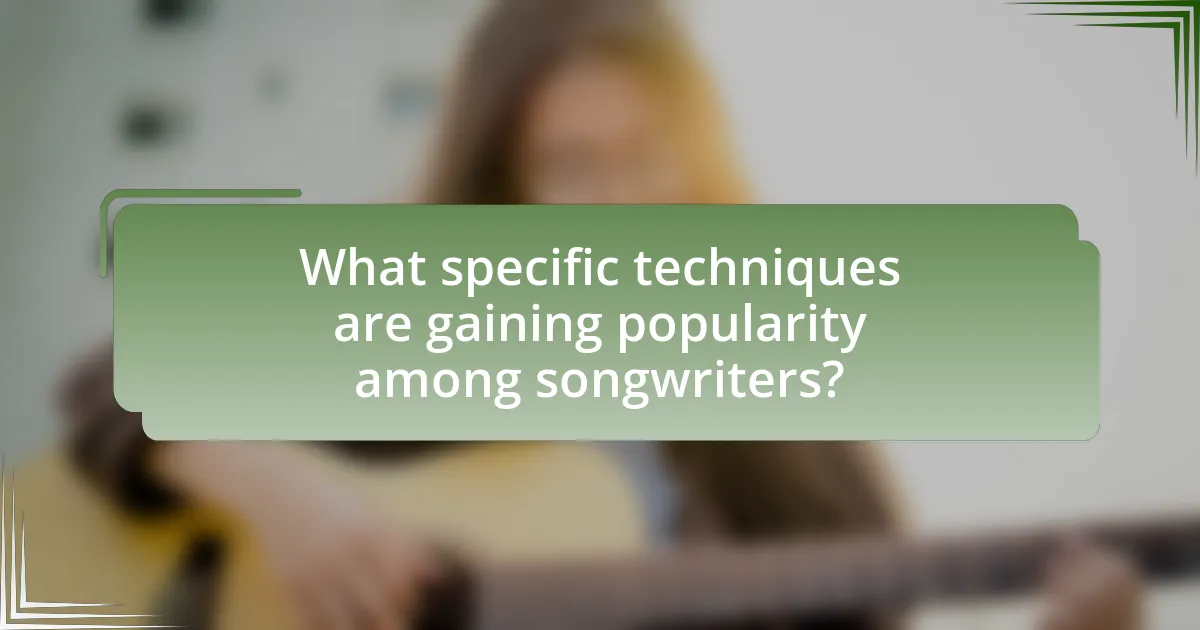
What specific techniques are gaining popularity among songwriters?
Collaborative songwriting is gaining popularity among songwriters, as it fosters creativity and diverse perspectives. This technique allows artists to combine their unique styles and ideas, resulting in more innovative and engaging music. Additionally, the use of digital tools and software for songwriting, such as online collaboration platforms and AI-assisted songwriting applications, is becoming increasingly common. These tools streamline the creative process and enable songwriters to experiment with different sounds and structures more efficiently. According to a 2022 survey by the Songwriters Guild of America, 65% of songwriters reported collaborating with others more frequently than in previous years, highlighting the shift towards teamwork in the songwriting process.
How are song structures changing in contemporary pop and rock music?
Contemporary pop and rock music is increasingly adopting non-traditional song structures, moving away from the classic verse-chorus format. This shift is evident in the rise of shorter songs, often under three minutes, and the incorporation of elements like pre-choruses, bridges, and instrumental breaks that defy conventional expectations. For instance, artists like Billie Eilish and Lil Nas X frequently utilize unexpected transitions and varied song lengths, reflecting a trend towards more experimental and fluid compositions. Additionally, the influence of digital streaming platforms has led to a focus on hooks and catchy melodies that capture listener attention quickly, further altering traditional songwriting approaches.
What are the most common song structures used today?
The most common song structures used today include the verse-chorus form, AABA structure, and the verse-chorus-bridge format. The verse-chorus form, characterized by alternating verses and a repeated chorus, is prevalent in pop and rock music, as it creates a catchy and memorable experience for listeners. The AABA structure, which consists of two verses (A), a bridge (B), and a return to the final verse (A), is often found in classic pop songs and provides a narrative arc. The verse-chorus-bridge format adds a contrasting section that enhances emotional depth and complexity, making it popular among contemporary artists. These structures are supported by data from music industry analyses, which show that songs adhering to these formats tend to perform better on charts and resonate more with audiences.
How do unconventional structures impact listener engagement?
Unconventional structures significantly enhance listener engagement by breaking predictable patterns, which captures attention and fosters curiosity. For instance, songs that deviate from traditional verse-chorus formats often create a sense of surprise, leading to increased emotional investment from the audience. Research indicates that tracks with non-linear arrangements, such as those found in progressive rock or experimental pop, can lead to higher replay value, as listeners are drawn to discover new elements with each listen. This engagement is supported by studies showing that songs with unexpected changes in tempo or key can evoke stronger emotional responses, thereby deepening the listener’s connection to the music.
What lyrical techniques are trending among pop and rock artists?
Trending lyrical techniques among pop and rock artists include the use of conversational language, storytelling, and emotional vulnerability. Conversational language creates relatability, allowing listeners to connect with the lyrics on a personal level. Storytelling techniques, often involving vivid imagery and character development, engage audiences by drawing them into a narrative. Emotional vulnerability is increasingly prevalent, as artists express personal struggles and experiences, fostering authenticity and deeper emotional connections with their audience. These techniques reflect a shift towards more intimate and relatable songwriting in contemporary music.
How are storytelling and personal experiences influencing lyrics?
Storytelling and personal experiences significantly influence lyrics by providing authenticity and emotional depth. Artists often draw from their own life events, relationships, and struggles to create relatable narratives that resonate with listeners. For instance, Taylor Swift’s songwriting frequently incorporates autobiographical elements, allowing her audience to connect with her experiences on a personal level. This approach not only enhances the emotional impact of the songs but also fosters a sense of intimacy between the artist and the audience, as seen in her albums like “Folklore” and “Evermore,” which are rich in storytelling.
What role does imagery play in modern songwriting?
Imagery plays a crucial role in modern songwriting by enhancing emotional connection and storytelling. It allows songwriters to create vivid mental pictures that resonate with listeners, making the lyrics more relatable and impactful. For instance, artists like Taylor Swift and Ed Sheeran frequently use imagery to evoke specific feelings and settings, which helps to deepen the listener’s engagement with the song. Research indicates that songs with strong imagery can lead to higher listener retention and emotional response, demonstrating the effectiveness of this technique in contemporary music.
How is the use of melody evolving in pop and rock songwriting?
The use of melody in pop and rock songwriting is evolving towards greater simplicity and catchiness, often prioritizing hooks that resonate with listeners. This trend is evident in the increasing prevalence of repetitive melodic phrases and the use of fewer notes, which enhances memorability and singability. For instance, contemporary hits frequently utilize a limited melodic range, as seen in songs like “Shape of You” by Ed Sheeran, which features a straightforward, repetitive melody that contributes to its widespread appeal. Additionally, the integration of digital production techniques allows for innovative melodic layering and manipulation, further shaping how melodies are crafted and perceived in modern music.
What are the characteristics of popular melodies in current hits?
Popular melodies in current hits typically feature catchy hooks, simple and repetitive structures, and a strong emotional appeal. These characteristics make melodies memorable and accessible, allowing listeners to easily engage with the music. For instance, many successful songs utilize a limited range of notes, often sticking to a pentatonic scale, which enhances singability. Additionally, the use of syncopation and rhythmic variation adds interest while maintaining a danceable quality. Research indicates that songs with these melodic traits tend to perform better on charts, as they resonate with a wide audience and encourage repeated listening.
How do artists balance melody with lyrical content?
Artists balance melody with lyrical content by ensuring that the musical elements enhance the emotional and narrative aspects of the lyrics. This involves crafting melodies that complement the rhythm and phrasing of the words, allowing the lyrics to be delivered effectively while maintaining listener engagement. For instance, a study by the University of Southern California found that successful pop songs often feature melodies that align with the emotional tone of the lyrics, creating a cohesive experience for the audience. By focusing on this synergy, artists can create songs that resonate more deeply with listeners, making both the melody and lyrics integral to the overall impact of the song.
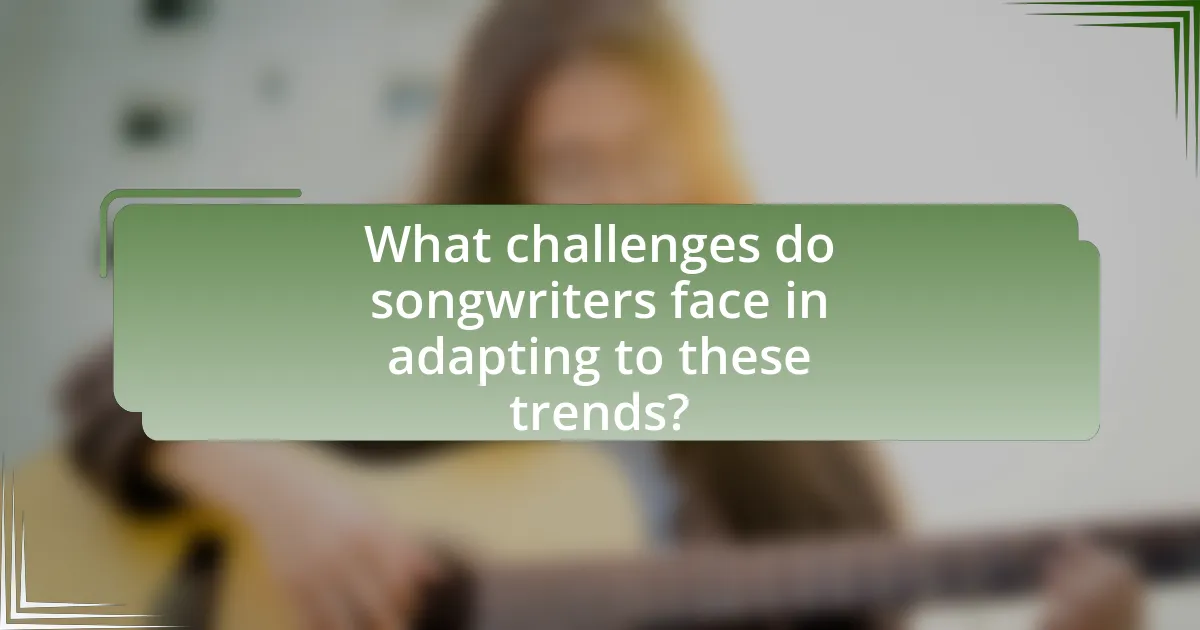
What challenges do songwriters face in adapting to these trends?
Songwriters face significant challenges in adapting to current trends in pop and rock music, primarily due to the rapid evolution of musical styles and listener preferences. The shift towards shorter song lengths, driven by platforms like TikTok, pressures songwriters to create engaging hooks quickly, often sacrificing depth and complexity. Additionally, the increasing reliance on digital production tools requires songwriters to possess technical skills that may not align with traditional songwriting practices. Furthermore, the saturation of the music market complicates the ability to stand out, as songwriters must navigate a landscape where originality is crucial yet increasingly difficult to achieve. These challenges highlight the need for songwriters to continuously innovate while balancing artistic integrity with commercial viability.
How do changing industry standards affect songwriting practices?
Changing industry standards significantly influence songwriting practices by dictating the structure, themes, and production techniques that artists adopt. For instance, the rise of streaming platforms has shifted focus towards shorter song lengths and catchy hooks to capture listener attention quickly, as evidenced by data showing that songs under three minutes are more likely to be streamed repeatedly. Additionally, the increasing importance of social media has led songwriters to incorporate relatable and shareable content, aligning with trends that prioritize authenticity and personal storytelling. These adaptations reflect the industry’s evolving demands, demonstrating how external factors shape creative processes in songwriting.
What are the implications of streaming on song length and structure?
Streaming has led to shorter song lengths and more standardized structures in popular music. This shift is primarily driven by the need to capture listener attention quickly and maximize streaming metrics, such as plays and engagement. Research indicates that songs under three minutes are more likely to be streamed repeatedly, as listeners tend to favor concise tracks that fit easily into playlists. Additionally, the prevalence of hooks and choruses early in songs has increased, aligning with streaming platforms’ algorithms that favor catchy, memorable segments to retain listener interest.
How do market demands influence creative freedom?
Market demands significantly restrict creative freedom by compelling artists to conform to popular trends and commercial expectations. For instance, the rise of streaming platforms has led to shorter song lengths and catchy hooks, as data shows that songs under three minutes tend to perform better in terms of listener retention and chart performance. This pressure to produce commercially viable music can limit an artist’s ability to explore innovative or unconventional themes, as they may prioritize marketability over artistic expression. Additionally, the prevalence of certain genres, such as pop, often dictates the sound and structure of new music, further constraining creative choices.
What obstacles do songwriters encounter when collaborating?
Songwriters encounter several obstacles when collaborating, including creative differences, communication issues, and logistical challenges. Creative differences arise when collaborators have varying artistic visions or styles, which can lead to conflicts over song direction. Communication issues often stem from misunderstandings or lack of clarity regarding roles and contributions, making it difficult to align on ideas. Logistical challenges, such as scheduling conflicts or geographical distances, can hinder the collaboration process, impacting the ability to work together effectively. These obstacles can significantly affect the songwriting outcome and the overall collaborative experience.
How can differing artistic visions lead to conflict in co-writing?
Differing artistic visions can lead to conflict in co-writing by creating disagreements over creative direction and thematic elements. When collaborators have distinct interpretations of a song’s message or style, it can result in tension and hinder the songwriting process. For instance, one writer may prioritize lyrical depth while another focuses on commercial appeal, leading to clashes in the final product. Research indicates that such conflicts are common in collaborative environments, as highlighted in studies on group dynamics in creative settings, which show that misalignment in artistic goals can disrupt teamwork and productivity.
What strategies can songwriters use to overcome collaboration challenges?
Songwriters can overcome collaboration challenges by establishing clear communication and setting defined roles within the songwriting process. Effective communication ensures that all collaborators understand each other’s ideas and expectations, which minimizes misunderstandings. For instance, regular check-ins and feedback sessions can help maintain alignment on the project’s direction. Additionally, defining roles—such as who handles lyrics, melody, or production—can streamline the creative process and reduce conflicts. Research indicates that successful collaborations often involve structured frameworks that facilitate creativity while respecting individual contributions, as highlighted in studies on teamwork dynamics in creative industries.
What best practices can emerging songwriters adopt to succeed in the current landscape?
Emerging songwriters can succeed in the current landscape by focusing on collaboration, leveraging digital platforms, and understanding their audience. Collaboration enhances creativity and broadens exposure, as many successful songs are co-written, allowing songwriters to learn from each other and combine diverse influences. Utilizing digital platforms, such as social media and music streaming services, enables songwriters to share their work widely and engage with fans directly, which is crucial in a landscape where traditional promotion methods are less effective. Understanding their audience involves analyzing listener preferences and trends, which can be achieved through data analytics tools that track streaming habits and social media interactions, helping songwriters tailor their music to meet market demands. These practices are supported by the rise of collaborative songwriting credits in the Billboard charts and the increasing importance of social media engagement in artist discovery.
How can songwriters effectively utilize technology in their process?
Songwriters can effectively utilize technology by incorporating digital audio workstations (DAWs) for composition, collaboration, and production. DAWs like Ableton Live and Logic Pro X allow songwriters to create, edit, and arrange music efficiently, facilitating a streamlined workflow. Additionally, cloud-based collaboration tools such as Splice enable real-time sharing and feedback among co-writers, enhancing creativity and productivity. The use of virtual instruments and plugins expands sonic possibilities, allowing songwriters to experiment with diverse sounds and styles. According to a 2021 survey by the Music Industry Research Association, 75% of songwriters reported that technology significantly improved their songwriting process, demonstrating its impact on modern music creation.
What tips can help songwriters stay relevant in a fast-changing industry?
Songwriters can stay relevant in a fast-changing industry by continuously adapting to new trends and technologies. Engaging with current musical styles, such as incorporating elements from genres like hip-hop or electronic music, allows songwriters to appeal to broader audiences. Additionally, utilizing digital platforms for collaboration and distribution, such as social media and streaming services, enhances visibility and reach. Research indicates that 70% of music consumption now occurs through streaming, highlighting the importance of digital presence. Furthermore, attending industry workshops and networking events can provide insights into emerging trends and foster connections with other artists and producers.
